#Gundam Iron-blooded Orphans
Explore tagged Tumblr posts
Text

#mobile suit gundam iron-blooded orphans#mobile suit gundam#gundam iron-blooded orphans#iron-blooded orphans#gundam#gundam ibo#ibo#anime gif#gundamnet#gifs#op#gundam kms
32 notes
·
View notes
Text
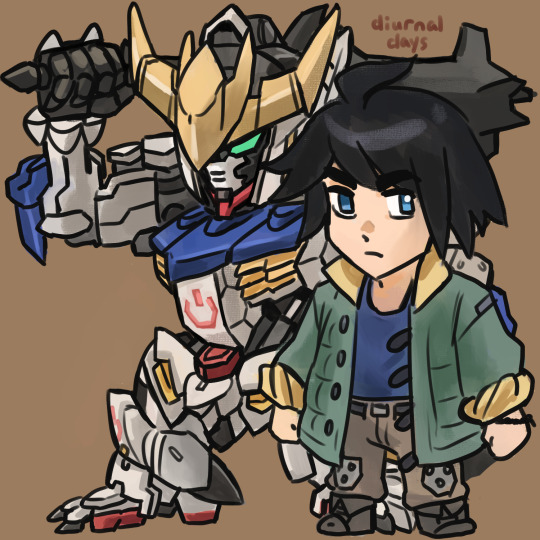
Palm-sized Barbatos + Mikazuki, by popular vote on twt
#mikazuki augus#gundam barbatos#gundam#iron-blooded orphans#g_tekketsu#ibo#gundam iron-blooded orphans
64 notes
·
View notes
Text
To Belong To Oneself - McGillis and Almiria's struggle for childhood autonomy

Although McGillis' marriage to Almiria and fervent desire to ensure her happiness are key points of the character, there is an understandable hesitance in the fanbase to discuss it in-depth. It's majorly uncomfortable to watch this adult man interact with a pre-teen in a pseudo-romantic fashion. The desire to just ignore it as best as possible is not unreasonable. But with the release of the new Almiria-focused side story, I really want to discuss what their relationship means to each of them and why it matters.
(Disclaimer: I don't think IBO does a fantastic job at disavowing less benevolent reads of the situation, but this post is about an interpretation of the text-as-is in which their relationship is, while inappropriate, not one of sexual abuse.)

The most striking thing established by "Almiria in Love" is that Almiria's desire to be perceived as an adult pre-dates even her first meeting with McGillis. It's a wish that exists de-coupled from all romantic ideas of love - a core of Almiria as an individual.
Through all of canon, Almiria is never seen playing with same age peers. Her only companions appear to be her adult maids and her adult older brother, however rarely he's home. While Gaelio, McGillis and Carta grew up around one another as playmates, Almiria appears to be fundamentally lonely. She is being raised isolated in a world made for adults, and she is painfully aware of it.
Almiria can't find anyone in the world to take her seriously. All her social contacts treat her (rightfully) as a child and there are no peer relations to balance this out. When Almiria desires to become a grown-up, it's a desire for autonomy, respect and companionship.
It's not that Almiria wants to be an adult in order to become a wife. It's that Almiria, after meeting McGillis, wants to become a wife in order to be an adult. Someone worthy of respect and consideration.
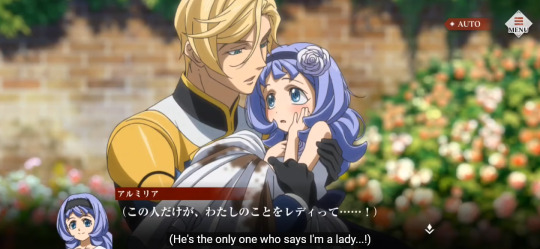
And that's precisely why she quickly becomes obsessed with McGillis once they do meet - McGillis is the only one who thinks of her wishes, her reputation, who gives her the same respect he'd give someone of the same standing. Almiria is too young to truly understand love, but she does understand the thrill of finally being taken seriously.
In a lot of ways McGillis is not just her adult fiancé but also her first friend - the childish nickname 'Macky' certainly speaks to it.

The other striking part of "Almiria in Love" is McGillis' offer to break the engagement should Almiria disagree with it. Is this a genuine offer? Is this a real possibility?
I'm going to argue that it's not. McGillis is as trapped as Almiria here - their engagement is made by their fathers, both of whom seem to see them as property and political tools. McGillis doesn't have any input here, no alternatives. He has to marry another of Sevens Stars bloodline to strengthen Iznario's position - and it can't be Carta, because Iznario is already her guardian and thus making further ties to her family would be redundant. It can't be Gaelio or Iok because the Seven Stars run on bloodlines (at least as far as appearances are concerned) - McGillis is expected to produce an heir eventually.
Yet McGillis gives Almiria a choice. Why?
McGillis does not want Almiria to ever feel as helpless and powerless as he once did. After all, if there is anybody who can understand the horror of being sold to an adult stranger, it's McGillis who has experienced it.
He treats Almiria with all the kindness he can muster in order to ensure that she feels like the wedding is, to a degree, her own choice. To give her that illusion of security and protect her from distress.
Through protecting Almiria, McGillis can protect his own younger self by proxy.


With that in mind, it's extremely important that McGillis uses "ore" as a personal pronoun for this line - a pronoun McGillis only uses on the show when he is speaking as a child or when he narrating his childhood and acting based on his childhood trauma. His usual personal pronoun is the more polite "watashi".
But here, in this moment, bathed in the golden glow of sunset, McGillis is speaking from the bottom of his traumatized heart. By meeting Almiria, he's been granted an opportunity to save himself.
But that doesn't mean that McGillis is actually in favor of child marriage. Rather, he seems to be the person most opposed to it.
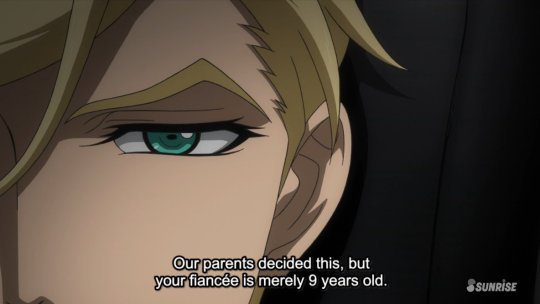

When the topic is first introduced, we are treated to a near-claustrophobic close-up shot of McGillis' darkening gaze. Even as he says that it's alright, he is clearly not happy about the concept.
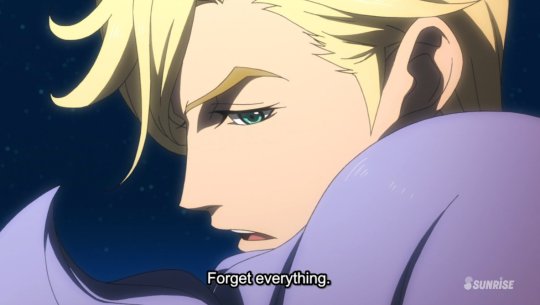
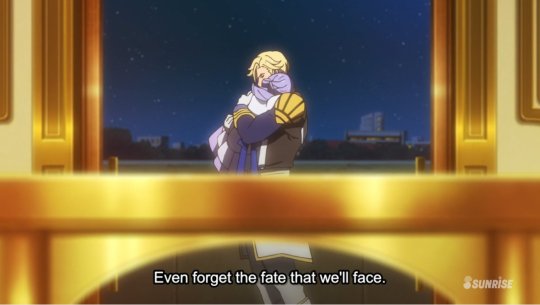
At the engagement party, we are shown a more obvious disavowing of the relationship forced upon them by their families. "The fate that we'll face" can only refer to their wedding in this context - chronologically, this takes place before McGillis sets any of his schemes into movement.
So then, why does McGillis play along with the pseudo-romantic aspects of their dynamic so much?

For one, he truly believes this. Almiria is the finest of all the ladies here, because she is innocent. Unspoiled by society, by vain quests for power. McGillis hates the high society he is constantly socializing in. He finds them arrogant, lazy and corrupt. Almiria represents complete purity to McGillis - the ultimate incarnation of 'something worth protecting'.
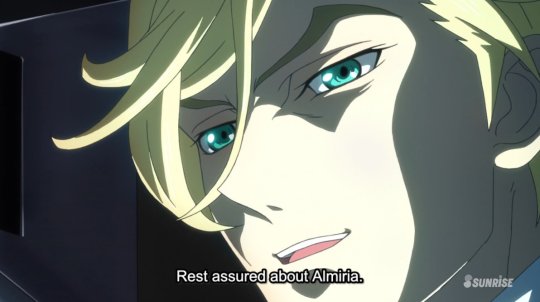

And then, of course, he wants to make Almiria happy. Almiria's happiness means saving himself, it means making Gaelio's death mean something, it means reaching his goals.
So, what makes Almiria happy? This play at romance certainly seems to! Ultimately, McGillis has no frame of reference for healthy child development. When he was Almiria's age, he already had a body count. How is he meant to interact with her? What boundaries does he need to set? It's anything but intuitive to him.
The easiest way to make her happy is to give her what she herself thinks she desires - to be treated as a full-fledged fiancée/wife.
I don't believe McGillis would ever touch her in a sexual way (he certainly knows the pain of that), but all the lip service to a romance between them? Sure, he'll play the part if it makes her smile. McGillis is a very theatrical person - give him a role, and he'll do it justice.

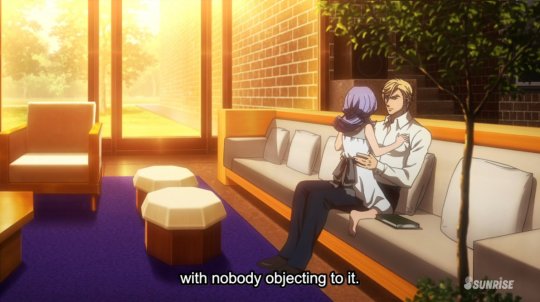


And even then, there is an interesting double meaning to scenes like this. When he promises Almiria a world in which everyone can love whomever they wish, Almiria interprets this to mean a world where their union is not a laughingstock. But for McGillis, who resents that they were forced to get engaged in the first place, this means a world in which Almiria could have grown up and chosen her own husband, whenever she was ready. A world in which weddings like theirs don't exist to begin with.
But of course, things can't go on like this forever. Almiria as the representation of a younger McGillis can't be kept safe forever, because McGillis is incapable of not picking at his own wounds.
His schemes, his attempt murder of her brother, all get back to Almiria.

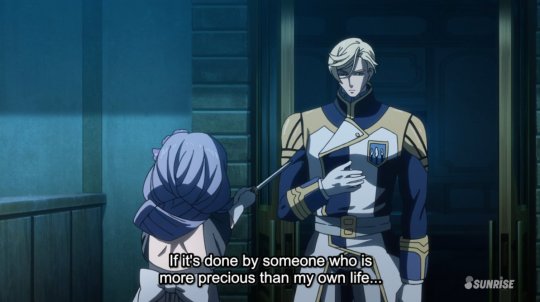
McGillis' "then kill me" lines are, in my opinion, likewise genuine. He does not truly believe that she would, but if there is anybody who's judgement he'd accept, it is hers. She's more precious than his life because she represents the core of his goals.
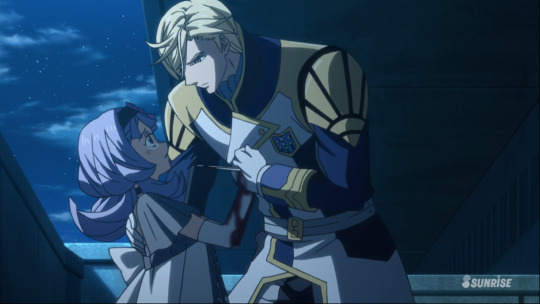

For that reason, what he cannot accept is her ending her own life - that'd mean it was all for nothing. I don't think it's a coincidence that Almiria is the only person McGillis ever discloses to that he used to be suicidal. Driving her to the same point of despair that he was in as a child is the hardest hitting punishment for McGillis.
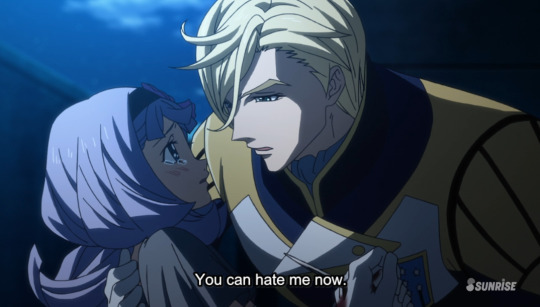


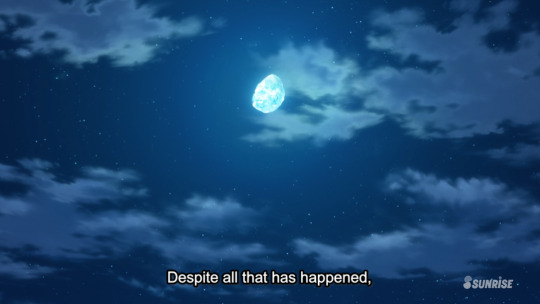

Still, he is unwilling to give up.
No matter how long it takes, he will make Almiria happy. He will save himself through her.


It is not coincidence that the hand wound he obtains in his attempt to save her almost costs him his life when it hinders his piloting. McGillis has already failed by letting it get this far. He's already tainted the one thing he wanted to preserve. It's only Isurugi's intervention that spares his life in that moment.
(As a side note, McGillis calling her a 'troublesome woman' in this moment of fleeting irritation once again speaks to how little sense he has for age as a genuine factor in anything. "What's a child? A small adult?" - part of the reason he can give Almiria the respect she craves is because he himself, in his stunted development, does not fully comprehend the gap between them.)
Almiria and McGillis are two people who seek their own fulfillment through the other. They are not in love, but they do love one another. Desperately, they crave the realization of their ideal self through their connection. Autonomy, safety. Happiness.

Naturally, McGillis dies with Almiria as his main regret.
He was going to make her happy. He was going to make himself happy. He was going to undo the past through her future.
One day, in a world where children can belong to themselves.
50 notes
·
View notes
Text
Emotional Continuity in Anime
What does it mean for a work of fiction to feel “realistic?” It’s a question I return to over and over because of how subjective the answer can be. The more I’ve thought about different possible takes, however, the more I’ve found that I resonate strongly with something I call “emotional continuity,” and it informs which series I view most positively.
View On WordPress
Broadly speaking, there are many types of…
11 notes
·
View notes
Text
Look, I’m not saying the next episode of Urdr Hunt looks like it has been targeted at me, specifically (screen-grabs from https://www.youtube.com/watch?v=-N3hzyuHjtA).

I mean that would be silly.

Wouldn’t it?

Sure, they’ve gone and stuck most of my favourite characters from both series and game in the same room together.

In what I am sure will be an extremely entertaining edition of ‘doofy gremlin child meets big bloodthirsty himbo’.

Plus, you know, they’re showing us what became of the Graze Custom Ryusei-Go after its slight Ein-related mangling.

(Those would be Hyakuren and Rouei parts on there.)

But come on. If they were *really* trying to laser-target this, they’d have Amida show up to bail everyone out at the end by proving once again that she is literally the best pilot in Iron-Blooded Orphans.

Oh.
Right.
I see how it is.
Fine! Stay tuned for reference notes on this episode consisting largely of key-smashes and prolonged screeching, I guess.


#GUNDAM#Gundam Iron-blooded Orphans#gundam ibo#Tekketsu no Orphans#g tekketsu#Iron-Blooded Orphans: Urdr Hunt#Urdr Hunt#Norba Shino#Yamagi Gilmerton#598#Amida Arca#game#app#screenshots
24 notes
·
View notes
Text


10 notes
·
View notes
Text
So I guess I’ll make this quick post cause I’m bored in the trailer for the new Mobile Suit Gundam IRON-BLOODED ORPHANS G app I noticed in the Urdu hunt Section of the trailer they were brief shots of both Naze and Shino Which gives me the impression we might see them in the Urdr hunt although I’m not 100% behind the predominant theory that Naze is this mysterious N character who organized the hunt but I still think he might appear since he has connections to Tamami Rakou that being said what we saw might just be a side story. On a different note In the brief shots we get of Shino and his mobile suit at first I thought it was a Hakukou but when I took a closer look I realized that I guess they had repaired his EB-06/tc2 Ryusei-Go and replace it’s smashed head with that of a Hakuou or another Teiwaz Mobile suit and the busted arm with one from the STH-05R Rouei as well as giving it the Roueis back Thrusters however I couldn’t quite make out the cockpit make.
youtube
#gundam iron-blooded orphans#gundam ibo#g tekketsu#tekketsu no orphans#Iron-Blooded Orphans: Urdr Hunt
2 notes
·
View notes
Text
One of my Spotify playlists ended so it started playing the mobile suit Gundam iron-blooded orphans soundtrack
#I'm going to watch it because the soundtrack sounds really good#to hell with the déjà vu#gundam iron-blooded orphans#gundam#soundtrack
1 note
·
View note
Text

As the kids say, just @ me next time, @phynali
whenever someone is like "[X] is so good but you can't just recommend it casually bc it has every trigger warning under the sun" that in itself is a recommendation. all the truly good shit needs a minimum of 5 disclaimers or it can't possibly reach the level of visceral catharsis necessary to be classified as a masterpiece. the funnier variant of this is when you come across a callout post for a piece of media that ends up reading like a recommendation instead
#can't remember if I gave you the full laundry list of warnings when I/we recced it to you#but I'm sure the 'this is a beautiful nightmare' vibe was a big part of it#Gundam Iron-blooded Orphans#Tekketsu no Orphans#queue who
34K notes
·
View notes
Text






Gaelio and Ein
#mobile suit gundam iron-blooded orphans#mobile suit gundam#gundam iron-blooded orphans#gundam ibo#gundam#iron-blooded orphans#ibo#gifs#op#guy leo ball dough win#oin#chevalbeglade#gundamnet
35 notes
·
View notes
Text
It would be so awesome...


It would be so cool...

#DO IT#THREE IN A ROW COME ON BABY LET'S GET IT#mobile suit gundam#iron-blooded orphans#the witch from mercury#gquuuuuux#gundam gquuuuuux#kudelia aina bernstein#akatsuki augus mixta bernstein#atra mixta#kudatra#suletta mercury#miorine rembran#sulemio#Amate Yuzuriha#Nyaan#Machu#Haro#Beanie haro#lmfao#me rambles
435 notes
·
View notes
Text
New Gundam series announced
This is the new featured Gundam




#gundam#gundam universal century#gunpla#mobile suit gundam#uc gundam#mobile suit gundam universal century#g witch#gundam the witch from mercury#gundam ibo#gundam iron blooded orphans#iron blooded orphans#gundam wing#00 gundam
334 notes
·
View notes
Text
Yes and also with reference to my last.
Well done, @thedancingwalrus-blog. Well done.
God I'm a sucker for characters who are so utterly loyal to someone that they're completely unhinged. Characters who have no moral compass except their overwhelming devotion to whoever they've chosen to listen to. That's the good shit
115K notes
·
View notes
Text
IBO reference notes on . . . the aesthetics of the mobile frame
I'm having a rough time writing this week (I just need to torture Gaelio some more, why is this so haaaard?!) so here's something to keep my hand in regardless. I had a couple of posts planned on the mobile suits of the Post Disaster setting, one about the meanings applied to Gundams – which I shall complete at some point because it's interesting – and one ranking the various 'suits using criteria such as 'excellent round boy, no notes' – which I'm likely to ditch because it's quite boring. But thinking about that got me considering the reasons I clicked hard with IBO's art direction in the first place. So let's look into why it causes my brain to make so many pleasing whirring noises.
A distinction that makes a difference
To start with, this is in contrast to other Gundam series' aesthetics. While I have a certain fondness for the Gundam Wing designs and I enjoy the way the Dauntless, Valiant, etc. reimagine the Universal Century stalwarts for Gundam X, most iterations' mobile suits are firmly 'OK' for me. Neither very interesting, nor something I find anything in to especially dislike.
Iron-Blooded Orphans, however, introduces a concept that sets it apart: the mobile frame. That is, each mecha is built around a base skeleton that is the 'true' machine; everything else is modular and interchangeable. As far as I can tell, this is the only series in the franchise to do this. Other Gundam shows expose inner workings from time to time, but these are usually unique to a particular model of 'suit. Whereas in IBO, multiple different types of 'suit can share the same kind of frame.
Moreover, the fact they are built around an inner frame is made explicit in the art, so the 'suits look – slightly daft as it may sound – much more mechanical than, say, your average UC mecha. These are things approximating the human form, not something you can replicate with a guy in a costume, and that makes them appear somewhat less fanciful and slightly more like actual military hardware.
Which is a cheat, obviously. It's tweaking a genre convention to fit a particular tone: this is not a show in which 'suits are going to start magically bending time and space; it's the one in which they beat seven shades of brick-dust out of each other with giant lumps of metal. Fundamentally, these are no less silly than the more 'filled in' designs that came before. It just appeals to me to see the illusion being given extra depth.
But there's more to it than that.
Atoms of design
Several different types of mobile frame appear in IBO – eight, to be exact: Rodi, Hexa, Gundam, Valkyrja, Geirail, Graze, Teiwaz/Io, and Reginlaze (I count the Teiwaz and Io frames as one since they are functionally identical). These are all visually distinct and easy to distinguish when placed in the finished mobile suits. Yet they also share a common root element: the Ahab reactor.
Most Gundam shows have some sort of wibble-physics black-box to explain why giant humanoid robots are a sensible means of warfare. In the P.D. timeline, this takes the form of 'Ahab particles' that are generated by some form of quantum nonsense inside a drum-shaped reactor. The particles create pseudo-gravity and EM waves that interfere with communications and tracking, and the reactors are effectively infinite batteries, so we get artificial gravity and inertial control, comms black-outs and stealth in space, and the necessary wattage to power a mecha, all for the price of one.
That's the technobabble, anyway. Practically speaking, the Ahab reactor is a design element that must be integrated into each of the mobile frames. And I love this. I love setting arbitrary little rules and using them to create a coherent aesthetic. Because now each frame needs to have a big drum shape in it somewhere (or two, to create the Gundam frame's unique silhouette). A unifying commonality that still permits wide variation.
It's not always necessary to have designs reflect a concept of shared technology. That depends on what the story is doing. Witch From Mercury, for example, explicitly has multiple branches of mobile suit design on display at once, to delineate between 'suits produced by different companies. However, I enjoy the way IBO emphasises that the various mecha are all applications of the same base technology, especially as it gets at something easy to overlook about how the world is set up.
You see, while the Gundams get the reputation as these massively powerful weapons from a lost past, that is true of the majority of non-Gjallarhorn mobile suits. Rodis and Hexas are the most common frames and both predate the Gundam frame's development. Everyone who isn't Gjallarhorn or Teiwaz is using machinery at least 300 years old, never mind that it might be covered in brand new armour.
Those space pirates raiding ships in the Jupiter-sphere? The colonists trying to seize control of their living conditions? That country hurriedly upgrading its military for a modern challenge? They're all recycling the same frames that fought the war out of which the systems they're currently struggling to live with extend. It's incredibly thematically resonant, not to mention pretty close to the truth of the things IBO is assaying in its fiction.
Visceral shorthand
However, I think the most clever thing about the mobile frame model is the way it lends itself to in-the-moment storytelling. Having established the skeletons underlying each mecha, the show can freely expose them as required to demonstrate exactly how badly a fight is going.
IBO abandons the lightsabers and laser-guns of its predecessor shows in favour of a more grounded and brutal approach to combat. That is to say: thanks to additional technobabble, breaking through the armour of a mobile suit requires either something very sharp, going very fast, or something very heavy, also going very fast. Swords, clubs, maces, and heavy-gauge bullets are the order of the day, leading to a lot of crumpling and crushing, and more specifically, bits of armour being ripped off the frame.
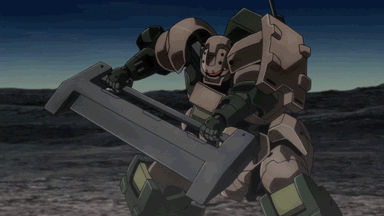
It's a great shorthand for 'oh that was a hit', applied generously to all sides, to emphasise the damage being done while also making it clear the machines can technically still function in such a state. Barbatos actively starts out extra-skeletal, while 'suits like the Reginlaze Julia keep going when stripped of their surface layer. Even the unfortunate Graze Ritter on the back of which Mikazuki surf-boards down from orbit is visibly coming apart around its frame, underlining how tough the cores of these things are.
Furthermore, it increases the sense that the human component of a mobile suit is extremely frail by comparison. When you a have weapons structured around extremely durable inner workings, it draws attention to the vulnerability of the cockpit. Because in most of the frames, that's part of what goes on top. Rodi and Io frames have integrated control cabins, but the rest do not. On most of them, the pilot sits at what is nominally the most heavily protected section (the chest), but in fact, they are a little way in front of the piece that can be actively relied on not to break (the reactor).
Or to put it another way: a mobile suit pilot is visibly more likely to die in battle before the war machine they are strapped to does. Skewering the cockpit with something pointy is a deeply feasible strategy, and that vulnerability stems from design limitations imposed by the chosen structure of the mecha. The reactor has to go somewhere central. The mobile suit is built around a set frame. The armour will detach before the limbs break. So on and so forth, ad drill-knees, underscoring how cheap life is next to the hardware of war.
Making it about bones
To sum up, it's a neat concept, well executed. Mobile frames allow for visual coherence while permitting design variation and customisation. They are used to underscore the brutality of the combat, adding weight to blow-by-blow animation and to the general sense of danger for the cast. And they make IBO's mecha stand out from the pack, which to me is a big mark in their favour.
There's another point that delights me too, one I can best illustrate with some images. If you look at the at the Calamity War era frames, you'll see that the Rodi (left) and Hexa (centre) are both heavily robotic in outline. They have complex hands but are otherwise quite blocky, with very inhuman heads. The Gundam frame (right), however, has a more organic design, its points of movement more closely corresponding to the human body, and (uniquely) two eyes placed about where you'd expect.

Now clearly the Gundam is inheriting franchise design considerations (the 'man in a suit' look of the '79 cartoon) but within the fiction, it works brilliantly with the conceit of Gundams perfecting the man/machine interface. Of course it looks closer to a person; it's meant to be a more natural extension of the pilot than the frames that came earlier, to enable the split-second timing and instinctive movement required to beat the mobile armours.
We also see this running in the opposite direction. The Valkyrja (far left) is actually closer to the Gundam's sensibilities than its other contemporaries (it was developed at the same time), but its successors, the Geirail and then Graze, are even more robotic than the Rodi and Hexa, with considerably simplified structures. Even the hands are much more chunky and functional.
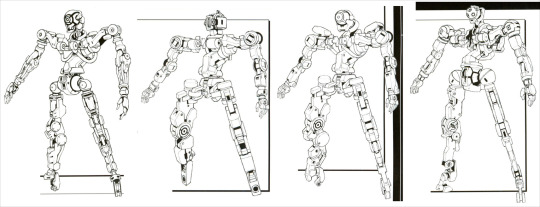
The narrative is both of a technological decline and of the requirements of mass-production. In the post-War society, mobile suit combat is less of an issue, so the 'suits don't need to be as complex. It's only when Gjallarhorn's position as top-dog in the solar system is threatened that they invest in something closer to the Valkyrja, with the Reginlaze (far right) being designed to allow a non-augmented pilot to compete with things like Gundam Barbatos.
I really like that degree of thought and detail in something that isn't especially relevant to the story, but adds to it once you know about it.
Other reference posts include:
IBO reference notes on … Gjallarhorn (Part 1)
IBO reference notes on … Gjallarhorn (Part 2)
IBO reference notes on … Gjallarhorn (corrigendum) [mainly covering my inability to recognise mythical wolves]
IBO reference notes on … three key Yamagi scenes
IBO reference notes on … three key Shino scenes
IBO reference notes on … three key Eugene scenes
IBO reference notes on … three key Ride scenes
IBO reference notes on … the tone of the setting
IBO reference notes on … character parallels and counterpoints
IBO reference notes on … a perfect villain
IBO reference notes on … Iron-Blooded Orphans: Gekko
IBO reference notes on … an act of unspeakable cruelty
IBO reference notes on … original(ish) characters [this one is mainly fanfic]
IBO reference notes on … Kudelia’s decisions
IBO reference notes on … assorted head-canons
IBO reference notes on … actual, proper original characters [explicit fanfic -- as in, actually fanfic. None of them have turned up in the smut yet]
#GUNDAM#Gundam Iron-blooded Orphans#gundam ibo#Tekketsu no Orphans#g tekketsu#reference#notes#mobile frames#mobile suits#design
20 notes
·
View notes
Text
Number's and capacity in IBO
It's always interested me That you'll have times in the Gundam franchise when we will get stats about mobile suits and ships like how many were produced and deplored or how big a mobile suit compliment a ship can handle for people who like having exact numbers however, at least I find that some of this information is kind of lacking in IBO of course part of that is down to my inability to read or translate Japanese so the information I seek could be out there I just can't read it. Like for other Gundam shows, there are art books for the IBO anime that give sketch art and layouts of buildings and vehicles which some of I think have been translated onto the wiki pages the rest I can have fun extrapolating about based on what I know.
Mobile suits
I think it’s been established that mobile suits in IBO while usable are expensive to maintain partly for development and maintenance costs then compound that with the fact that Gjallarhorn is the only one allowed to produce Ahab reactors to power them. I went back and noticed that other than organizations with a lot of capital like Gjallarhorn, Teiwaz, or the Zan clan you can't have them in big numbers, and even for those big groups resources can be limited, a few examples I could think of are the noble families of Gjallarhorn just keeping their family Gundam in the vault 'cause they don't have the money to maintain and use it, it ‘s also been said that the EB-05s Schwalbe Graze had a high operational and development cost and Teiwaz was only able to produce 44 STH-05 Hyakuren even with the cost saving of just salvaging reactors from the debris field, granted both the Schwalbe Graze and Hyakuren are well-performing machines. In the case of both organizations it seems like they were able to also mass produce more dumbed-down versions of their more sophisticated suits like the STH-16 Shiden or the EB-06 Graze or the really dumb-down AEB-06L Hloekk Graze for everyone else seems like the only other option was to salvage leftover suits from the calamity war mostly Rodi and Hexa frames while maybe easier to find seem to still require upkeep.
Ships
In terms of ships it doesn't seem like we get a lot of exacts they give the number of mobile suit catapults but other than that all I could find in terms of mobile suit capacity was the skipjack-class being able to carry 10 suits but that's when the sketch and designs come in they give more detail, looks at the hangers for Halfbeak-class ships I can't really say for sure looking at the sketches and going back and looking at the show I'd say maybe six that get hung on those clamps you see there.
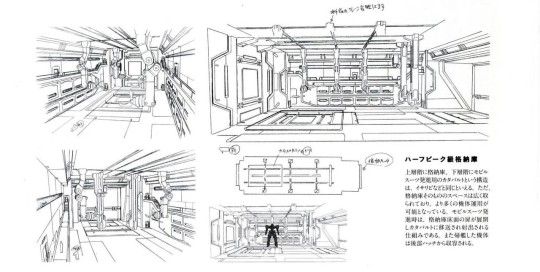
there is also the half beak-class owned by Jasley Donomikols which opposed to the gjallarhorn models having the hanger at the bottom of the ship it appears that the front of the ship has been along geared to accommodate all the mobile suits but really we only get a look at the launch Bay so I don't really know, however Jasley did say that they outnumbered Tekkadan so I'm going to guess high teens low twenties.

when it comes to armored assault ships like the TIR-0009 Hammerhead or the NOA-0093 Isaribi The number of suits seems subjective in the sketch below you can see three mobile suits lined up maybe you can fit a fourth in there.

The thing is I also remembered something and went back to watch the sixth episode of the urdr hunt game and when Wistario and his crew pick up the Ahab waves of the Rakou Pirate ship they detect one armored assault ship and six mobile suits so my guess is 4 to 6.
Trying to guess the number of mobile suits on the NOA-0132 Hotarubi was a little trickier 'cause even with being a Teiwaz subsidiary I was under the impression that Tekkadan wasn't that rich to afford a whole bunch of suits at once don't think they had a full stock before they broke with Teiwaz so I'm just guessing on the number of hangers and mobile suit bays which based on the concept art there are eight hangers on each side with at least six mobile suit bays in each that make for a total of forty-eight possible mobile suits.

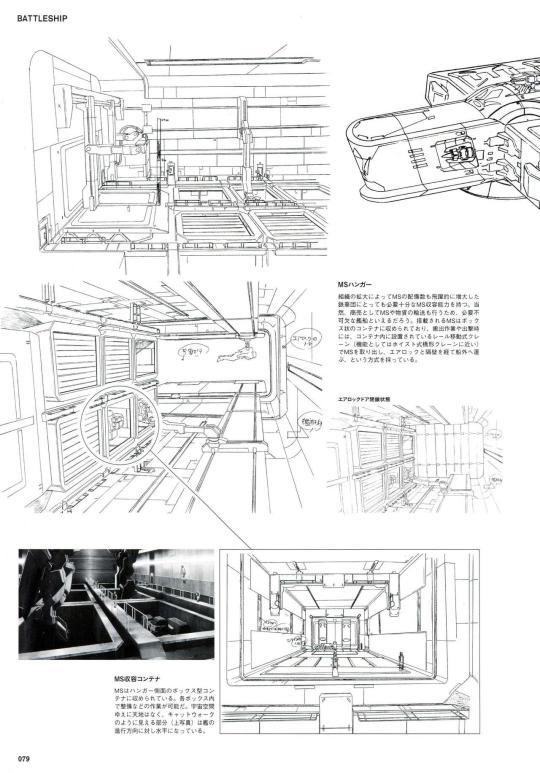
I know at the end of the day this is just nitpicking but like I said for people who like exact numbers like me to get a better scale of the world for more detailed storytelling information like this is appreciated.
1 note
·
View note
Text
Ok, I just wanna get this outta the way. I hate Gushion's pilot. I'm in between "He's so unremarkable that I don't even remember him enough to hate him," and, "OMG I HATE HIM SO MUCH!"
Anyways
OH. MY. GOD. HAVE YOU SEEN GUSHION?!
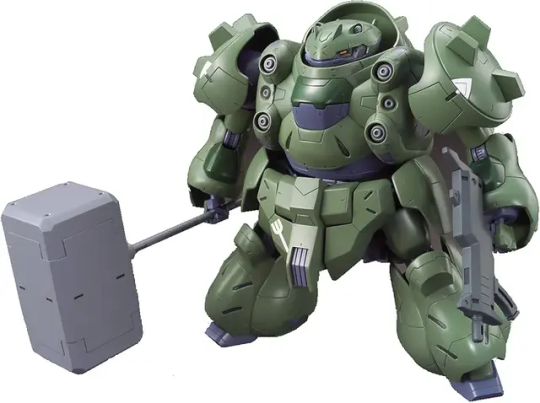
HE'S JUST A LI'L GUY WITHA A HAMMER THAT PROBABLY WEIGHS A DECENT CHUNK OF HIS WEIGHT. Dude. The HG's joints aren't even strong enough to lift the hammer. This li'l guy is tiny and perfect and cute and the best thing to ever happen to HG gunpla. He's so adorable!
There have got to be more Gushion fans out there
He's literally just a chunky little guy with a big hammer. I MUST HAVE HIMMMMMM!
194 notes
·
View notes